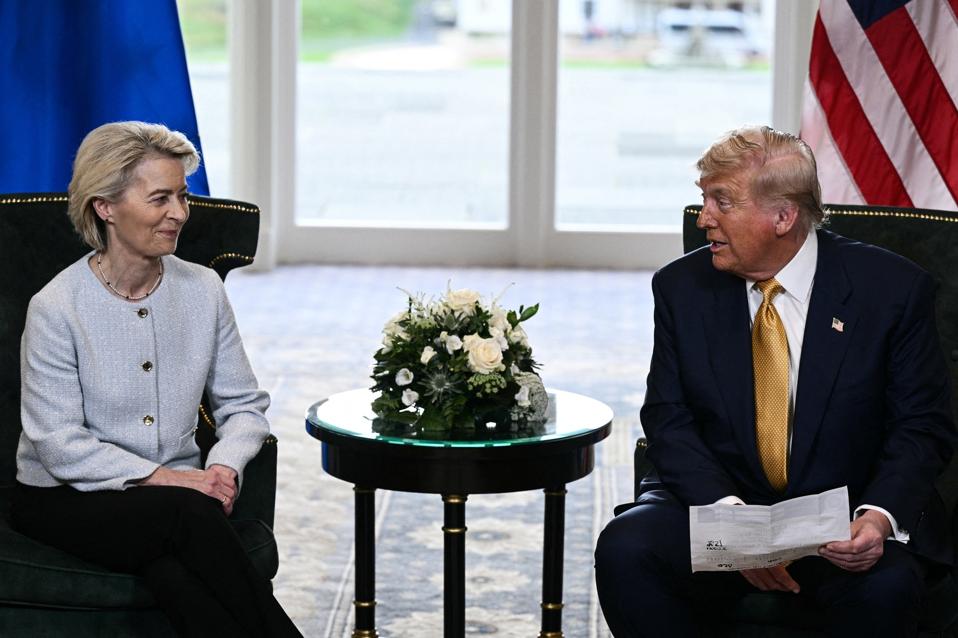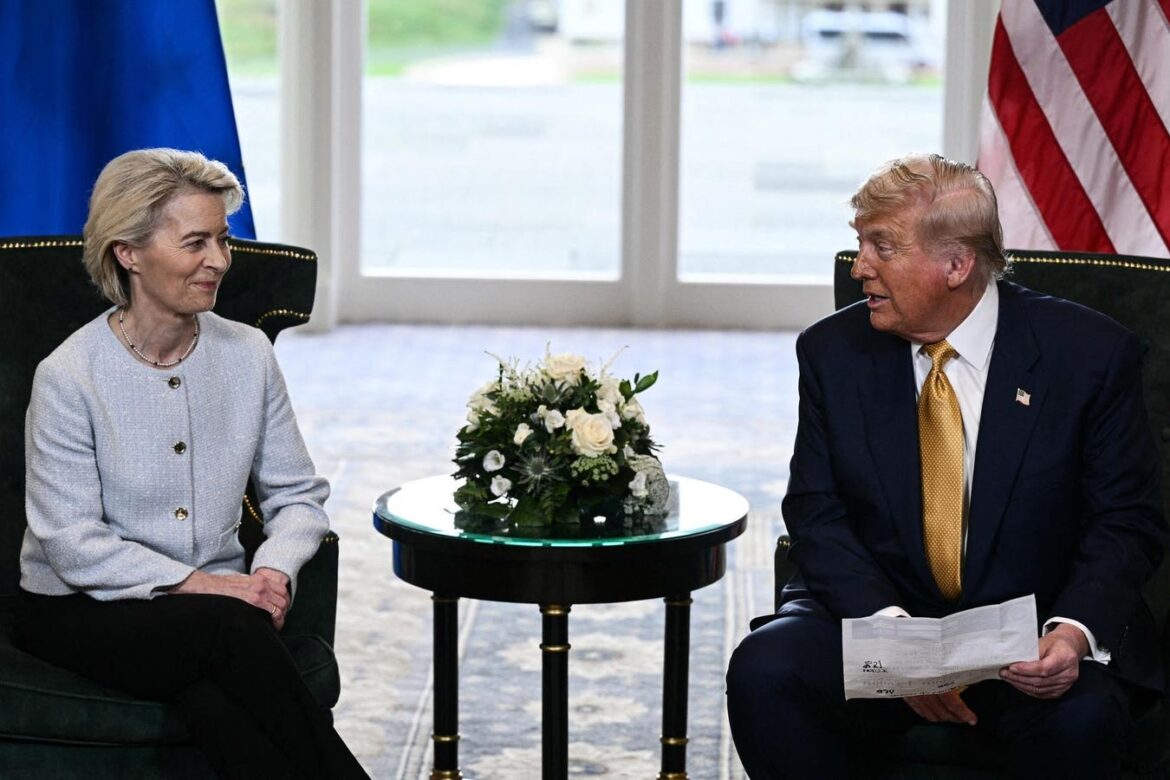
US President Donald Trump (R) and European Commission President Ursula von der Leyen (L) speak to the press after agreeing on a trade deal between the two economies following their meeting, in Turnberry south west Scotland on July 27, 2025, on the third day of his visit to the country, since his second tenure as President began. US President Donald Trump said on July 27, 2025 that he had reached a trade agreement with European Union chief Ursula von der Leyen. (Photo by Brendan SMIALOWSKI / AFP) (Photo by BRENDAN SMIALOWSKI/AFP via Getty Images)
AFP via Getty Images
Nobody wanted a trade war, but the price to avoid it is too high anyway. For everybody. The recent agreement reached by European Commission President Ursula van der Leyen and the US President Donald Trump has halved the proposed 30% tariffs on all European products, but it leaves a bitter taste in the mouths of all European manufacturers. For Italy the U.S. remains the single largest export market, accounting for 24% of its total export value in wine. In 2024, the annual turnover of Italian wine exports was approximately $9.15 billion. Once the agreement was announced, reactions were not long in coming.
The Dissatisfaction Of The Wine Producers And The Minister’s Concern
The presidente of Consorzio Vini Valpolicella Christian Marchesini
Consorzio Tutela Vini Valpolicella
According to the secretary general of Unione Italiana Vini Paolo Castelletti, even if a 15% tariff is lower than the proposed 30%, this kind of deal cannot be satisfying for anybody because it’s extremely higher than the pre-tariff rate, which was almost zero. For a country like Italy, which prioritizes value for money, this is a devastating blow. The president of Consorzio Tutela Vini Valpolicella Christian Marchesini is of the same opinion. “Any duty or barrier on wine trade causes extremely significant damage to the European and Italian wine industry and to Valpolicella as well – claimed Marchesini – Pending the final negotiations, the 15% duty projected in the medium and long term would have a very serious economic impact. At present, we can say that, according to today’s leaks, the uncertainty that will affect us until next autumn is just as serious.” The Italian Minister of Agriculture Francesco Lollobrigida has always shown optimism about the deal, but now he admits: “Wine is what concerns us most.” Meanwhile, the deadline of the 1st of August, when the tariffs should have been effective, has been delayed up to the 7th, although the 15% remains.
Tariffs and Dollar Weakness Are A Dangerous Combination
ROME, ITALY – APRIL 29: The Minister of Agriculture, Food Sovereignty and Forests (MASAF), Francesco Lollobrigida (Photo by Simona Granati – Corbis/Corbis via Getty Images)
Corbis via Getty Images
Recent studies by Confindustria, the main association representing Italian manufacturing and service companies, show that imposing US 15% tariffs on all Italian goods imported in America could cause Italy to lose €22.6 billion in exports (approximately $24.6 billion). The wine sector only would lose $520 million. The tariffs are not the only obstacle however, the dollar devaluation also complicates things. These two factors combined can make Italian wines less competitive than others in the US markets. Unione Italiana Vini (UIV), the Italian wine companies association, has recently raised the alarm: 15% tariffs penalize at least 80% of the sector. If in January 2025 (pre-tariff) the markup from the winery to the retailer was 123%, with the new tariff regime soars to 186%. As a result, American consumers ultimately pay almost twice the tariff rate in increased prices due to the compounding markup structure throughout the distribution chain.
HOUSTON, TEXAS – MARCH 8: Wines from Italy are on display at Houston Wine Merchant in Houston, Tuesday, March 18, 2025. Houston Wine Merchant is one of the small business owners presumably to be affected if President Donald Trump carries through on his threats. (Yi-Chin Lee/Houston Chronicle via Getty Images)
Houston Chronicle via Getty Images
Not All The Wines Are Created Equal
The Italian wines most affected by the new tariffs are those with the highest US market exposure: Moscato d’Asti from Piedmont (60% export) and red wines from this region (31%), Pinot Grigio (48%), Chianti Classico (46%) and other Tuscan DOC reds (35%), Prosecco (27%). Overall the new tariff regime will mostly affect the most popular wines, which are affordable to almost every pocket, more than the premium ones. Wines such as Brunello di Montalcino, Barolo, Amarone della Valpolicella, and Super Tuscans are already expensive to begin with, and therefore intended for high-spending consumers. Indeed, in this case, a bottle that was pre-tariffed and cost $25 ex-cellar, $55.75 on the retail shelf, and $150.00 at the restaurant, would now cost $71.50 in the wine shop and $195.00 at the restaurant. If you’re a rich person, spending an extra $45 on an excellent Italian wine won’t break the bank.
Who Wins And Who Loses
The Unione Italiana Vini President Lamberto Frescobaldi (L)
Accademia Italiana della Vite e del Vino
What has been reported so far are estimates data on behalf Italian wine producers. But what about their overseas trading partners? According to the UIV president Lamberto Frescobaldi, they and their customers could be the ones who will lose the most: “The tariffs will not only affect consumption, but will also have a severe impact on the US economy, with total damages amounting to $25 billion” he said. This estimate was calculated by the UIV Observatory and is based on the direct, indirect, and induced impact of all wine in the US in the distribution, retail, and transportation phases alone. Wine America quantified this impact at $144.4 billion in its “United States 2025 Economic Impact Study.” This figure includes not only sales revenues but also the value generated along the distribution chain, the positive effects of wages and the resulting purchasing power, and the increase in demand for goods and services in other related sectors. A significant effect, but one that would lose $25 billion with tariffs on wines at 15%. And things could even get worse: if nothing changes, the revenue loss could reach almost $1.7 billion in the next 12 months. At the time this article was written, there had not been a joint final statement yet, and the details of the deal remain unclear and subject to ratification. In short, the uncertainty keeps on reigning supreme. However, this can mean that perhaps there is still room for further negotiations. Any manufacturer in Europe is crossing their fingers and hoping for the best. With the current deal, it seems that the EU and the US have avoided a trade war, but despite the appearance, the price they could pay is significant for both.


Dining and Cooking